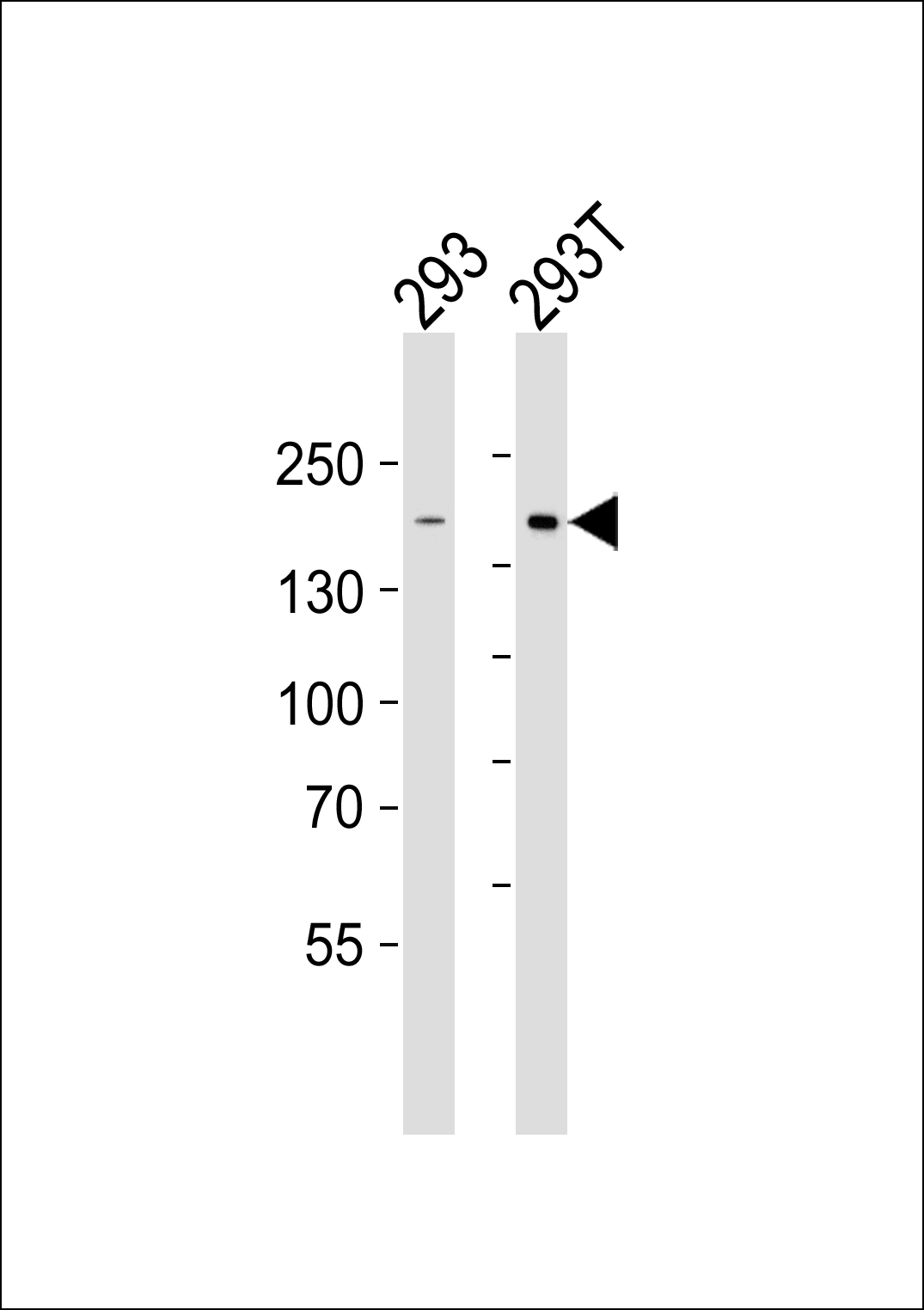DIAPH1 Antibody (N-term)
Purified Rabbit Polyclonal Antibody (Pab)
- 产品详情
- 实验流程
- 背景知识
Application
| WB, E |
|---|---|
| Primary Accession | O60610 |
| Reactivity | Human, Mouse |
| Host | Rabbit |
| Clonality | Polyclonal |
| Isotype | Rabbit IgG |
| Calculated MW | 141347 Da |
| Gene ID | 1729 |
|---|---|
| Other Names | Protein diaphanous homolog 1, Diaphanous-related formin-1, DRF1, DIAPH1, DIAP1 |
| Target/Specificity | This DIAPH1 antibody is generated from a rabbit immunized with a KLH conjugated synthetic peptide between 18-52 amino acids from the N-terminal region of human DIAPH1. |
| Dilution | WB~~1:500-1:1000 E~~Use at an assay dependent concentration. |
| Format | Purified polyclonal antibody supplied in PBS with 0.09% (W/V) sodium azide. This antibody is purified through a protein A column, followed by peptide affinity purification. |
| Storage | Maintain refrigerated at 2-8°C for up to 2 weeks. For long term storage store at -20°C in small aliquots to prevent freeze-thaw cycles. |
| Precautions | DIAPH1 Antibody (N-term) is for research use only and not for use in diagnostic or therapeutic procedures. |
| Name | DIAPH1 |
|---|---|
| Synonyms | DIAP1 |
| Function | Actin nucleation and elongation factor required for the assembly of F-actin structures, such as actin cables and stress fibers (By similarity). Binds to the barbed end of the actin filament and slows down actin polymerization and depolymerization (By similarity). Required for cytokinesis, and transcriptional activation of the serum response factor (By similarity). DFR proteins couple Rho and Src tyrosine kinase during signaling and the regulation of actin dynamics (By similarity). Functions as a scaffold protein for MAPRE1 and APC to stabilize microtubules and promote cell migration (By similarity). Has neurite outgrowth promoting activity. Acts in a Rho-dependent manner to recruit PFY1 to the membrane (By similarity). In hear cells, it may play a role in the regulation of actin polymerization in hair cells (PubMed:20937854, PubMed:21834987, PubMed:26912466). The MEMO1-RHOA- DIAPH1 signaling pathway plays an important role in ERBB2-dependent stabilization of microtubules at the cell cortex (PubMed:20937854, PubMed:21834987). It controls the localization of APC and CLASP2 to the cell membrane, via the regulation of GSK3B activity (PubMed:20937854, PubMed:21834987). In turn, membrane-bound APC allows the localization of the MACF1 to the cell membrane, which is required for microtubule capture and stabilization (PubMed:20937854, PubMed:21834987). Plays a role in the regulation of cell morphology and cytoskeletal organization. Required in the control of cell shape (PubMed:20937854, PubMed:21834987). Plays a role in brain development (PubMed:24781755). Also acts as an actin nucleation and elongation factor in the nucleus by promoting nuclear actin polymerization inside the nucleus to drive serum-dependent SRF-MRTFA activity (By similarity). |
| Cellular Location | Cell membrane {ECO:0000250|UniProtKB:O08808}. Cell projection, ruffle membrane {ECO:0000250|UniProtKB:O08808} Cytoplasm, cytoskeleton. Cytoplasm, cytoskeleton, microtubule organizing center, centrosome. Cytoplasm, cytoskeleton, spindle. Cytoplasm {ECO:0000250|UniProtKB:O08808}. Nucleus {ECO:0000250|UniProtKB:O08808} Note=Membrane ruffles, especially at the tip of ruffles, of motile cells. {ECO:0000250|UniProtKB:O08808} |
| Tissue Location | Expressed in brain, heart, placenta, lung, kidney, pancreas, liver, skeletal muscle and cochlea. Expressed in platelets (PubMed:26912466). |
For Research Use Only. Not For Use In Diagnostic Procedures.
Provided below are standard protocols that you may find useful for product applications.
BACKGROUND
Acts in a Rho-dependent manner to recruit PFY1 to the membrane. Required for the assembly of F-actin structures, such as actin cables and stress fibers. Nucleates actin filaments. Binds to the barbed end of the actin filament and slows down actin polymerization and depolymerization. Required for cytokinesis, and transcriptional activation of the serum response factor. DFR proteins couple Rho and Src tyrosine kinase during signaling and the regulation of actin dynamics. Functions as a scaffold protein for MAPRE1 and APC to stabilize microtubules and promote cell migration (By similarity). Has neurite outgrowth promoting activity (By similarity). In hear cells, it may play a role in the regulation of actin polymerization in hair cells. The MEMO1-RHOA- DIAPH1 signaling pathway plays an important role in ERBB2- dependent stabilization of microtubules at the cell cortex. It controls the localization of APC and CLASP2 to the cell membrane, via the regulation of GSK3B activity. In turn, membrane-bound APC allows the localization of the MACF1 to the cell membrane, which is required for microtubule capture and stabilization. Plays a role in the regulation of cell morphology and cytoskeletal organization. Required in the control of cell shape.
REFERENCES
Lynch E.D.,et al.Science 278:1315-1318(1997).
Totoki Y.,et al.Submitted (MAR-2005) to the EMBL/GenBank/DDBJ databases.
Schmutz J.,et al.Nature 431:268-274(2004).
Ota T.,et al.Nat. Genet. 36:40-45(2004).
Morita K.,et al.J. Dermatol. Sci. 44:11-20(2006).
终于等到您。ABCEPTA(百远生物)抗体产品。
点击下方“我要评价 ”按钮提交您的反馈信息,您的反馈和评价是我们最宝贵的财富之一,
我们将在1-3个工作日内处理您的反馈信息。
如有疑问,联系:0512-88856768 tech-china@abcepta.com.























 癌症的基本特征包括细胞增殖、血管生成、迁移、凋亡逃避机制和细胞永生等。找到癌症发生过程中这些通路的关键标记物和对应的抗体用于检测至关重要。
癌症的基本特征包括细胞增殖、血管生成、迁移、凋亡逃避机制和细胞永生等。找到癌症发生过程中这些通路的关键标记物和对应的抗体用于检测至关重要。 为您推荐一个泛素化位点预测神器——泛素化分析工具,可以为您的蛋白的泛素化位点作出预测和评分。
为您推荐一个泛素化位点预测神器——泛素化分析工具,可以为您的蛋白的泛素化位点作出预测和评分。 细胞自噬受体图形绘图工具为你的蛋白的细胞受体结合位点作出预测和评分,识别结合到自噬通路中的蛋白是非常重要的,便于让我们理解自噬在正常生理、病理过程中的作用,如发育、细胞分化、神经退化性疾病、压力条件下、感染和癌症。
细胞自噬受体图形绘图工具为你的蛋白的细胞受体结合位点作出预测和评分,识别结合到自噬通路中的蛋白是非常重要的,便于让我们理解自噬在正常生理、病理过程中的作用,如发育、细胞分化、神经退化性疾病、压力条件下、感染和癌症。






